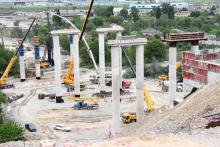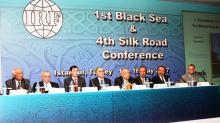Georgia’s government aspires to turn the country into a regional transport-transit hub, and with renovated and expanded transportation infrastructure it knows that the country can offer significant opportunities to others in the region, and globally – Gordon Feller writes
The Caucasus Transit Corridor (CTC) is the key transit-route between Western Europe and Central Asia for oil and gas, as well as dry cargo. CTC is part of TRACECA (TRAnsport Corridor Europe to Central Asia). This is the shortest route

The economic growth of Georgia and its capital Tblisi have been hampered by its poor transport connections
Georgia’s government aspires to turn the country into a regional transport-transit hub, and with renovated and expanded transportation infrastructure it knows that the country can offer significant opportunities to others in the region, and globally – Gordon Feller writes
The Caucasus Transit Corridor (CTC) is the key transit-route between Western Europe and Central Asia for oil and gas, as well as dry cargo. CTC is part of3297 TRACECA (TRAnsport Corridor Europe to Central Asia). This is the shortest route between Europe and the Caucasus and Central Asia via Black sea ports. TRACECA is an alternative to the north corridor running through Russia and Belarus and the southern corridor running through Turkey and Iran. Over time, the latter has become less competitive due to international sanctions imposed on Iran.
The development of oil resources is projected to increase the east-west flow of oil and associated products. The associated economic activities within the Caucasus and Central Asia will increase the flow of goods. As a result, the Georgian government is putting a strong emphasis on the upgrade of the East-West Highway (EWH).
A concerted effort to upgrade this transit corridor began during the 1990s as a part of the EU’s TRACECA programme, which financed a pre-feasibility study for an upgrade to four lanes of the highway from the port of Poti on the Black sea to the Azeri border. Georgia’s government started the upgrade of the first 15km of the EWH from outside of Tbilisi at Natakhtari to Agaiani (km43 mark) from its own budget. The project has continued the upgrade from Agaiani (around the km43 mark) to Igoeti (at the km56 mark).
The World Bank is providing hundreds of millions of dollars to improve Georgia’s logistics and transport services within, but also cross-borders along the CTC. Georgia aims to become a regional transport and logistics hub and to do it plans to attain both Turkey's Logistics Performance Index (regional leader) and Poland’s LPI.
EWH carries over 60% of Georgia’s total foreign trade and is seen as central in the government's strategy: transform Georgia into a transport and logistics hub for trade between Central Asia and the Far East on the one and Turkey and Europe on the other hand. EWH is part of the European route E-60, which is the second longest E-road running from Brest, France on the Atlantic coast, to Irkeshtam Kyrgyzstan (on the border with China).
In Georgia, EWH runs from the Red Bridge at the Azerbaijan border to the Poti Port at the Black Sea coast for around 392km (2% of the Georgian road network length, and slightly less than a quarter of the international road network). It has an average traffic of about 7,800 vehicles/day and traffic annual growth rate of around 7%.
EWH accounts for 23% of the vehicle use on Georgian roads, which represents 47% of traffic on the country's international roads. The 2014 Enabling Trade Index (ETI) ranks Georgia 56 out 138 countries for availability and quality of transport infrastructure. The improvement of EWH will improve connectivity between the Caspian Sea and Black Sea, lowering cost of transport and logistics and improving Georgia’s connections to global markets.
The government is committed to completing EWH by 2020 and in recent years has accorded high priority to completing the upgrading of EWH (392km) to international motorway standards (2x2 lanes). The government opted to finance this project using its own budget and a significant support of the international financing institutions.
The World Bank financed four road improvement projects along EWH to complement the government's initial investment from Tbilisi, and assistance is also being provided by other IFIs. Around 130km of EWH have already been upgraded of which 70km were funded by the World Bank through the first two highway improvement projects. Work is on-going to complete an additional 177km by 2016 with the support of the World Bank (32km), Asian Development Bank (33km), European Investment Bank (55km), and Japan’s International Cooperation Agency (58km).
The transport sector is one of the fastest growing in the Georgian economy: Transport and communication have tripled their contribution to the total output, from 4.6% of GDP in 1996 to 15% in 2005. In physical terms the movement of goods by land modes nearly trebled over the same period from 2.3 billion tonne-kilometres to 6.8 billion tonne-kilometres. Nevertheless, in terms of tonne-kilometres, total land transport movement only amounts to about one third of the levels in 1990, a reflection of the civil war in 1991/92 and the problems associated with the breakup of the USSR. Transport infrastructure remains deficient, and hinders growth in other sectors, including agriculture.
All of the key national actors know that transport infrastructure must improve if Georgia wants to benefit from its strategic transit location, to support its recovering economy, and to integrate its whole population to the national economy.
Poor infrastructure and cumbersome processes inhibit Georgia from fully exploiting its transit economy potential. Transit is dominated by oil product transport, which represents about three times the volume of non-oil transport. Non-oil trade mostly comprises Armenian and Azeri goods, which account for a significant share of the turnover of Georgia’s ports. Georgia has not yet been able to realise the transit potential from Central Asian countries. Despite being the closest maritime gateway to nearly all Central Asian countries, the Georgian route presently accounts for a negligible portion of the foreign trade of these countries. Long transit times, poor road conditions, multiple borders that have to be crossed, and the number of times cargo needs to be handled, together with the formal and informal payments and delays, explain the limited use of the Caucasus route. The high fuel cost and the significant reduction in corruption in the Georgia should improve Georgia’s transit competitiveness.
Limited transport infrastructure adds to the cost of doing business and leaves much of the population out of the national economy. Constraints in infrastructure add to the cost of doing business, deter foreign investment, add time and costs to the transit corridor, and leave large segments of the population out of mainstream economic activities. Analyses show a close correlation between poverty in rural households and the extent to which they are linked to markets. Poor transport infrastructure partly explains why almost two-thirds of rural household agricultural production is for self-subsistence and that about 20% of rural households do not trade at all. Poor connectivity has also contributed to the weak linkages between farmers and agro-processors as few intermediate agents, wholesalers, or farmer-based organisations exist. One in-depth World Bank study indicated that local road and bridge rehabilitation projects generate clear economic benefits at the community level, decreasing the amount of barter trade and increasing the number of small and medium enterprises.
The national government’s transport strategy is to support market integration. The government transport sector strategy is to develop the infrastructure and institutional setting of the sector to support market integration and to maximise the country’s potential as a transit economy. To that end, the main ports and airports are being offered as concessions to the private sector, the railways are moving towards the development of profit centres and the adoption of modern marketing techniques, customs are being reformed to improve trade facilitation and reduce corruption, a decentralisation process is under way to devolve local infrastructure to local governments, and a massive effort is being made, with the support of the international financial community, to upgrade the road network and reduce travel costs.
Georgia’s roads consist of international motorways (1,495km), state highways (3,354km), and local roads (15,480km). The poor condition of much of the network in Georgia, caused by a lack of investment and maintenance, represents a significant barrier to growth. Roads in Georgia often lack shoulder markings and centerlines, increasing the risk of crashes, which in 2005 amounted to 1164, with 259 deaths and 1,492 injured representing a fatality rate of 10/10,000 vehicles among the worst of eastern European countries.
Road funding for the upgrading and modernisation of the main international arteries of the country is being supported by multilateral and bilateral organisations. There are five main roads and highways in Georgia, totalling 859km. These are: Poti–Tbilisi–Red Bridge (E60); Mtskheta–Kazbegi–Larsi; Sarpi–Batumi–Samtredia; Khashuri–Akhaltsikhe–Turkish border; Tbilisi–Marneuli–Guguti.
Room to improve
The often rough topography, the low-capacity highways (often only 7m wide without shoulders), the inadequate maintenance regime, the poor road condition, the poor technical standards of vehicles, and other adverse conditions mean the traffic flow is slow and the risk of a crash is high.
The World Bank has stated that its EWH project development objectives are:
• to contribute to the gradual reduction of road transport costs and improve access, ease of transit, and safety along the central part of Georgia's East-West corridor, through upgrading a segment of the East-West Highway from Tbilisi to Rikoti; and,
• to strengthen the capacity of the government, RDMED and the local road construction industry to plan and manage better the road network.
For road users, the project would lead to better road quality and level of serviceability, avoiding or deferring costly congestions expected on the basis of mid-term traffic projections, better road safety through new alignments and city bypasses, avoiding hazardous crossing of urban areas by heavy transit traffic, and savings derived from shorter travel times.
Among the key project outcome indicators are two high priority items:
• Reduction in transit time/vehicle operating cost from Agaiani to Igoeti
• Planning is done on a multi-year basis using the RDB
• Number of km upgraded for Agaiani-Igoeti
• Agaiani-Igoeti built incorporating safety specifications
• RDB covers all network and in use
• Multi-year investment and maintenance program updated
• Review and revision of technical manuals and teaching materials
• Adoption of new technical standards and specifications for road pavements and new geometric design standards for road design
• New technical standards and specifications for road pavements and new geometric design standards for road design are used
• Revised human resource policies
• A new transport (or road) concession law is developed
The Caucasus Transit Corridor (CTC) is the key transit-route between Western Europe and Central Asia for oil and gas, as well as dry cargo. CTC is part of
The development of oil resources is projected to increase the east-west flow of oil and associated products. The associated economic activities within the Caucasus and Central Asia will increase the flow of goods. As a result, the Georgian government is putting a strong emphasis on the upgrade of the East-West Highway (EWH).
A concerted effort to upgrade this transit corridor began during the 1990s as a part of the EU’s TRACECA programme, which financed a pre-feasibility study for an upgrade to four lanes of the highway from the port of Poti on the Black sea to the Azeri border. Georgia’s government started the upgrade of the first 15km of the EWH from outside of Tbilisi at Natakhtari to Agaiani (km43 mark) from its own budget. The project has continued the upgrade from Agaiani (around the km43 mark) to Igoeti (at the km56 mark).
The World Bank is providing hundreds of millions of dollars to improve Georgia’s logistics and transport services within, but also cross-borders along the CTC. Georgia aims to become a regional transport and logistics hub and to do it plans to attain both Turkey's Logistics Performance Index (regional leader) and Poland’s LPI.
EWH carries over 60% of Georgia’s total foreign trade and is seen as central in the government's strategy: transform Georgia into a transport and logistics hub for trade between Central Asia and the Far East on the one and Turkey and Europe on the other hand. EWH is part of the European route E-60, which is the second longest E-road running from Brest, France on the Atlantic coast, to Irkeshtam Kyrgyzstan (on the border with China).
In Georgia, EWH runs from the Red Bridge at the Azerbaijan border to the Poti Port at the Black Sea coast for around 392km (2% of the Georgian road network length, and slightly less than a quarter of the international road network). It has an average traffic of about 7,800 vehicles/day and traffic annual growth rate of around 7%.
EWH accounts for 23% of the vehicle use on Georgian roads, which represents 47% of traffic on the country's international roads. The 2014 Enabling Trade Index (ETI) ranks Georgia 56 out 138 countries for availability and quality of transport infrastructure. The improvement of EWH will improve connectivity between the Caspian Sea and Black Sea, lowering cost of transport and logistics and improving Georgia’s connections to global markets.
The government is committed to completing EWH by 2020 and in recent years has accorded high priority to completing the upgrading of EWH (392km) to international motorway standards (2x2 lanes). The government opted to finance this project using its own budget and a significant support of the international financing institutions.
The World Bank financed four road improvement projects along EWH to complement the government's initial investment from Tbilisi, and assistance is also being provided by other IFIs. Around 130km of EWH have already been upgraded of which 70km were funded by the World Bank through the first two highway improvement projects. Work is on-going to complete an additional 177km by 2016 with the support of the World Bank (32km), Asian Development Bank (33km), European Investment Bank (55km), and Japan’s International Cooperation Agency (58km).
Key connection
The physical location of Georgia makes it a key transport link on the most direct route between the Black Sea and the Caspian Sea, and the Central Asian countries. It is situated on the historic “Silk Road”, which the current TRACECA initiative seeks to emulate.The transport sector is one of the fastest growing in the Georgian economy: Transport and communication have tripled their contribution to the total output, from 4.6% of GDP in 1996 to 15% in 2005. In physical terms the movement of goods by land modes nearly trebled over the same period from 2.3 billion tonne-kilometres to 6.8 billion tonne-kilometres. Nevertheless, in terms of tonne-kilometres, total land transport movement only amounts to about one third of the levels in 1990, a reflection of the civil war in 1991/92 and the problems associated with the breakup of the USSR. Transport infrastructure remains deficient, and hinders growth in other sectors, including agriculture.
All of the key national actors know that transport infrastructure must improve if Georgia wants to benefit from its strategic transit location, to support its recovering economy, and to integrate its whole population to the national economy.
Poor infrastructure and cumbersome processes inhibit Georgia from fully exploiting its transit economy potential. Transit is dominated by oil product transport, which represents about three times the volume of non-oil transport. Non-oil trade mostly comprises Armenian and Azeri goods, which account for a significant share of the turnover of Georgia’s ports. Georgia has not yet been able to realise the transit potential from Central Asian countries. Despite being the closest maritime gateway to nearly all Central Asian countries, the Georgian route presently accounts for a negligible portion of the foreign trade of these countries. Long transit times, poor road conditions, multiple borders that have to be crossed, and the number of times cargo needs to be handled, together with the formal and informal payments and delays, explain the limited use of the Caucasus route. The high fuel cost and the significant reduction in corruption in the Georgia should improve Georgia’s transit competitiveness.
Limited transport infrastructure adds to the cost of doing business and leaves much of the population out of the national economy. Constraints in infrastructure add to the cost of doing business, deter foreign investment, add time and costs to the transit corridor, and leave large segments of the population out of mainstream economic activities. Analyses show a close correlation between poverty in rural households and the extent to which they are linked to markets. Poor transport infrastructure partly explains why almost two-thirds of rural household agricultural production is for self-subsistence and that about 20% of rural households do not trade at all. Poor connectivity has also contributed to the weak linkages between farmers and agro-processors as few intermediate agents, wholesalers, or farmer-based organisations exist. One in-depth World Bank study indicated that local road and bridge rehabilitation projects generate clear economic benefits at the community level, decreasing the amount of barter trade and increasing the number of small and medium enterprises.
The national government’s transport strategy is to support market integration. The government transport sector strategy is to develop the infrastructure and institutional setting of the sector to support market integration and to maximise the country’s potential as a transit economy. To that end, the main ports and airports are being offered as concessions to the private sector, the railways are moving towards the development of profit centres and the adoption of modern marketing techniques, customs are being reformed to improve trade facilitation and reduce corruption, a decentralisation process is under way to devolve local infrastructure to local governments, and a massive effort is being made, with the support of the international financial community, to upgrade the road network and reduce travel costs.
Georgia’s roads consist of international motorways (1,495km), state highways (3,354km), and local roads (15,480km). The poor condition of much of the network in Georgia, caused by a lack of investment and maintenance, represents a significant barrier to growth. Roads in Georgia often lack shoulder markings and centerlines, increasing the risk of crashes, which in 2005 amounted to 1164, with 259 deaths and 1,492 injured representing a fatality rate of 10/10,000 vehicles among the worst of eastern European countries.
Road funding for the upgrading and modernisation of the main international arteries of the country is being supported by multilateral and bilateral organisations. There are five main roads and highways in Georgia, totalling 859km. These are: Poti–Tbilisi–Red Bridge (E60); Mtskheta–Kazbegi–Larsi; Sarpi–Batumi–Samtredia; Khashuri–Akhaltsikhe–Turkish border; Tbilisi–Marneuli–Guguti.
Room to improve
The often rough topography, the low-capacity highways (often only 7m wide without shoulders), the inadequate maintenance regime, the poor road condition, the poor technical standards of vehicles, and other adverse conditions mean the traffic flow is slow and the risk of a crash is high.
The World Bank has stated that its EWH project development objectives are:
• to contribute to the gradual reduction of road transport costs and improve access, ease of transit, and safety along the central part of Georgia's East-West corridor, through upgrading a segment of the East-West Highway from Tbilisi to Rikoti; and,
• to strengthen the capacity of the government, RDMED and the local road construction industry to plan and manage better the road network.
For road users, the project would lead to better road quality and level of serviceability, avoiding or deferring costly congestions expected on the basis of mid-term traffic projections, better road safety through new alignments and city bypasses, avoiding hazardous crossing of urban areas by heavy transit traffic, and savings derived from shorter travel times.
Among the key project outcome indicators are two high priority items:
• Reduction in transit time/vehicle operating cost from Agaiani to Igoeti
• Planning is done on a multi-year basis using the RDB
• Number of km upgraded for Agaiani-Igoeti
• Agaiani-Igoeti built incorporating safety specifications
• RDB covers all network and in use
• Multi-year investment and maintenance program updated
• Review and revision of technical manuals and teaching materials
• Adoption of new technical standards and specifications for road pavements and new geometric design standards for road design
• New technical standards and specifications for road pavements and new geometric design standards for road design are used
• Revised human resource policies
• A new transport (or road) concession law is developed











